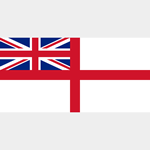Commemorated: | |||
| 1. Grave: | Zanzibar (Grave Island) Cemetery | Grave 143 | |
| 2. Book: | The (1921) Masonic Roll of Honour 1914-1918 | Pg.125 | |
| 3. Memorial: | The (1940) Scroll - WW1 Roll of Honour | 3A GQS | |
Awards & Titles: | |||
Early Life :
The update to this legend has been prompted by the academic researches of Karen Giles. The previous narrative centred principally on the Sinking of the "Pegasus".Born 7th May, 1876 at Charlton, Dover to father Charles and mother Charlotte, of 14 London Road, Buckland, Dover (1881 Census), she later of 20, Princes Road, Notting Hill, W.London. [UK, British Army and Navy Birth Marriage and Death Records 1730-1960]. The 1891 Census shows that he had at least 6 sisters and 4 brothers. His father is recorded as a “Journeyman Butcher”, possibly meaning he travelled around – perhaps a slaughterman in today’s parlance.
Ernest’s parents moved to Dover from Maidstone by the time their first child, Mary Elizabeth was born, suggesting a move to a marital home. The Dover residence, located at 14 London Road is a set of terraced houses with shops – so it is possible that his father ran a butchery from this address [Google Maps], with the rather large family living above. (Today is Turners Models – Radio Controlled Professionals). The proximity to the Port of Dover may have proved a hook in Ernest’s childhood – it seems an easy leap, or at least walking distance, to assume that took an early interest in all things nautical, and that the comings and goings to the port inspired his future career.
Service Life:
Campaigns:
- The First World War 1914-1918, World-wide.
| Unit / Ship / Est.: HMS Pegasus |
Class and type: Pelorus class cruiser Displacement: 2,135 tons 2,740 tons full load Length: 300 ft (91 m) Beam: 36.5 ft (11.1 m) Draught: 17 ft (5.2 m) Propulsion: Two triple expansion steam engines, 7,000 hp Speed: 20 knots (37 km/h) when new Complement: 224 Armament: 8 x QF 4-inch (102 mm) guns 8 x 3 pdr guns 2 x 18-inch (457 mm) torpedo tubes |
| Action : HMS Pegasus, Sinking of |
HMS Pegasus In the early morning of September 20, 1914 HMS Pegasus was anchored in Zanzibar harbour, now part of Tanzania, having left her battle group, which included HMS Hyacinth and HMS Astraea, to attend to boiler and engine problems. The German light cruiser SMS Koenigsberg launched a surprise attack on the ship. Out-ranged and out-gunned, HMS Pegasus was incapacitated within eight minutes and the Captain, Commander Ingles, struck the colours to avoid further bloodshed. The ship sank later that day with the loss of 38 killed and 55 wounded. The hospital ship Gascon and Scottish ship Clan Macrae came to the aid of the survivors. The HMS Pioneer, Pegasus' sister ship, later assisted in the blockade of the Rufiji River where the Koenigsberg had taken refuge. Six of the eight guns of the Pegasus were salvaged and two, named Peggy III and Peggy IV, were used in the land campaign until 1916. Of the other four, two remained in Zanzibar, one was mounted on board the lake steamer Winifred and the last mounted at Mombasa where it survives to this day outside Fort Jesus museum. Twenty four of the British sailors that died in the battle were laid to rest in a mass grave in part of the naval cemetery on Grave Island, Zanzibar; the remaining fourteen were buried in the town cemetery but in 1971 were moved to Dar es Salaam war cemetery. The wreck was sold in 1955 for £500 and broken up for scrap, although large amounts of debris still remain on the seabed.
Leamington Spa Courier records the detail in its 25 September publication: The Story of the Action. The following account of the action in which H.M.S. "Pegasus" became "completely disabled" shows the unequal nature of the contest.
The "Koenigsbery" approached at full speed at 5 a.m. on Sunday, and disabled a British patrol boat with three shots. She then opened fire on the "Pegasus." Her shooting, which was very accurate, began at a range of 9,000 yards, closing to 7,000. All the broadside of the "Pegasus" was engaged, but her guns were disabled in fifteen minutes, when her fire ceased. After a lull of five minutes the "Koenigsberg" again opened fire for another quarter of an hour, the "Pegasus" being unable to reply.
Out of her crew of 234, no fewer than 25 were killed and 80 wounded. Nearly all the casualties occurred around the guns and on the upper deck. Lieut.-Commander Turner only survived long enough to be brought ashore.
The British flag was shot away twice, but was held up by hand by Marines. Apparently little or no damage was done to the "Koenigsberg" which then turned and steamed away to the south.
The naval correspondent of The Times says:- The little cruiser could only fall an easy prey, since she could neither get away nor reach her opponent with her guns. Zanzibar harbour affords no protection whatever, for it is practically an open roadstead, and it may be assumed that only an urgent necessity found the "Pegasus" cleaning her boilers and repairing machinery in such a place. As a fighting unit the Pegasus is no great sacrifice, but it is a sad ending to a little vessel which had done useful service to be completely disabled and lose such a large proportion of her crew.
At the time of the 1901 Census he is an Able-Bodied seaman, aged 24 and single. He is listed amongst the many servicemen stationed at Devonport, Royal Navy Barracks.
At the time of the 1911 Census he is recorded as a Petty Officer 1st Class, aged 34 and single. He was aboard HMS Impregnable, classed as a Boys Training Ship under the Command of Commander Philip A. Bateman-Champain at Plymouth Station, moored at Devonport 2nd April, 1911.
Detail :
De Ruvignys Roll of Honour Vol.3 records his service as "Service No. 162971(Devonport) Petty Officer Ernest Edward HIGHAMS, lost on HMS Pegasus, Sept. 1914"
For his service in the Great War, he was posthumously awarded the 1914 Star, the Victory Medal and the British War Medal (Pip, Squeak and Wilfrid). There is an annotation in remarks L.C. 1064/1914, which may refer to a medal clasp.
His date of Death: 20th September, 1914 is recorded across naval record including on the WW1 Pension Card and Ledgers and in the Navy Lists.
His grave is tended by the Commonwealth War Graves Commission and located Grave 143, Grave Island Cemetery, off Zanzibar, E. Africa, according to the UK, British Army and Navy Birth Marriage and Death Records 1730-1960.
Masonic :
| Type | Lodge Name and No. | Province/District : |
|---|---|---|
| Mother : | Lodge of Fortitude No. 105 E.C. | Devonshire |
Initiated | Passed | Raised |
14th June 1909 | 12th July 1909 | 9th August 1909 |
In 1909, on 8th March he became a Freemason and had taken all his ceremonial in consecutive months, receiving a Grand Lodge certificate in November of the same year. [UGLE Membership Registers]. He was initiated into Lodge of Fortitude No. 105, which was warranted to meet in 1759 on Plymouth, and had a long association with the 2nd Division of Marines [Lanes]. Unsurprisingly, they previously met in an impressive number of Public Houses, but by the time that Ernest was initiated, the Lodge was meeting at masonic halls in Plymouth. The Lodge of Fortitude was principally providing the Naval station with a masonic home. At the time of his initiation, he was recorded as a Petty Officer, Royal Navy and living at the R.N. Barracks in Devonport. He continued to pay his dues until he died – the ledgers in the United Grand Lodge of England recorded his death, but given the date of 20th May, 1914, some four months prior to the event on the “Pegasus”.
To conclude, Ernest was foremost a naval man through and through having risen through up to the highest non-commissioned ranks. He evidently enjoyed service life and had something to offer the Navy. After his long career, he continued to do his duty until the day he was killed with a number of his colleagues as a result of enemy action.
Source :
The project globally acknowledges the following as sources of information for research across the whole database:
- The Commonwealth War Graves Commission
- The (UK) National Archives
- Ancestry.co.uk - Genealogy, Family Trees & Family History online
- ugle.org.uk - The records of the United Grand Lodge of England including the Library and Museum of Freemasonry
Additional Source:
- Founder Researchers : Paul Masters & Mike McCarthy
- Researcher : Bruce Littley

